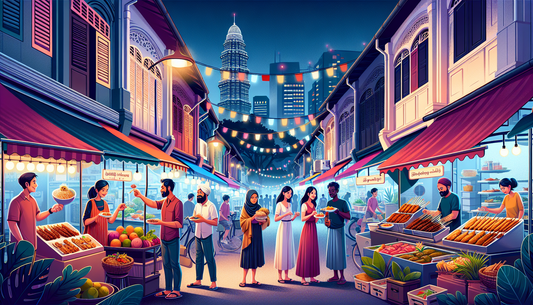
Redefining Culinary Excellence: The Shift in Singapore's Dining Scene
SizzleBot 3.0 RecipesShare
Singapore's dining scene is undergoing a transformative shift, blending tradition with innovative culinary techniques to redefine excellence. From prominent hawker centers to high-end restaurants, the gastronomic landscape is evolving, showcasing a diverse spectrum of flavors that reflect the nation’s multicultural heritage.
- Michelin-starred establishments like Odette and Burnt Ends continue to push culinary boundaries.
- Enrico Crippa's recent visit to Singapore brought a focus on sustainable dining practices, sparking new trends.
- The rise of homegrown chefs, such as Godfrey Wong of Open Farm Community, emphasizes local sourcing and seasonal ingredients.
- The annual Singapore Food Festival, held every July, now features more immersive experiences, highlighting the evolution of food culture.
- 2023 saw an increase in plant-based dining options, catering to the growing demand for sustainable cuisine. 🌱
- Notable food spaces like Jewel Changi Airport are integrating gourmet experiences with architectural brilliance, attracting both locals and tourists. 🏙️
As Singapore embraces innovation, its culinary excellence continues to captivate food enthusiasts from around the globe. 🍽️
In recent years, Singapore's dining scene has garnered significant attention, especially with the Michelin Guide making its mark in the region. The evaluation of restaurants has not only spotlighted culinary excellence but has also stirred conversations about inclusivity and diversity within the gastronomic community. As the Michelin Guide continues to influence diners, chefs, and restaurateurs alike, various stakeholders are rethinking what it means to be recognized in the world of fine dining.
The Michelin awards in Singapore began their journey in 2016 when the first guide was published, unveiling a range of acclaimed restaurants. This move elevated Singapore's stature on the global culinary map, presenting a blend of traditional and innovative Asian cuisines. Additionally, it has been pivotal in promoting local talent, showcasing an array of dining experiences that transcend conventional expectations.
However, recent dialogues have emerged questioning the criteria and the implications of Michelin ratings. Critics have pointed out that the awards often favor high-end, luxury establishments while overlooking modest, homegrown eateries that serve authentic, delicious meals. This dichotomy raises an essential discussion about what criteria truly define culinary excellence in a multicultural environment like Singapore, where diverse flavours abound.
The Influence of Michelin in Singapore
As Singapore continues to shine as a culinary hub, the Michelin Guide's influence remains strong. The awards have undeniably elevated the visibility of numerous restaurants, generating excitement among food enthusiasts. Chefs and restaurateurs, eager to earn a coveted star or plate, often feel the pressure to innovate. For many, the potential for increased patronage following a Michelin recognition can dictate business operations significantly.
In this environment, chefs like André Chiang and Janice Wong have become household names, celebrated not just for their award-winning cuisine but also for their efforts in presenting local ingredients in innovative ways. Restaurants such as Odette and 2am:dessertbar have gained acclaim, demonstrating the variety and depth of culinary talent in Singapore.
Reevaluating Awards and Inclusivity
Despite the excitement surrounding Michelin recognition, the conversation has shifted towards the need for a broader, more inclusive evaluation system. Many advocates within the culinary community argue that the focus on high-end establishments leaves out smaller, family-run operations that embody the heart of Singapore’s food culture. Michelin-starred or not, these eateries contribute significantly to the local culinary landscape.
The Michelin Guide has responded to these concerns by introducing new categories and designations in recent years. For instance, the Bib Gourmand award aims to acknowledge establishments offering exceptional food at more accessible price points. This recognition has proven essential for local eateries striving to maintain authenticity while balancing business viability.
Community Support and Local Eateries
Local support for neighborhood gems has gained momentum. Food patrons have rallied around these places, appreciating their dedication to genuine flavours. Notable food stalls and restaurants, such as the famed hawker centres, play a crucial role in feeding the local population while holding rich culinary traditions. This evolving appreciation demonstrates a shift in mindset among diners who increasingly favour authentic experiences over mere prestige.
The emergence of social media has also transformed how food is experienced in Singapore. Platforms like Instagram and TikTok allow food lovers to share their discoveries widely, often propelling lesser-known joints into the spotlight. As diners share their experiences, the collective voice nurtures an appreciation for all aspects of the dining spectrum, from street food to fine dining.
Navigating the Future of Michelin in Singapore
Moving forward, the Michelin Guide faces the challenge of navigating a complex culinary landscape filled with diverse preferences and evolving expectations. Locally, chefs and restaurateurs are calling for a re-evaluation of what constitutes excellence in the dining industry. The need for a thoughtful approach to recognition has never been more pronounced as various stakeholders advocate for a more equitable representation of Singapore’s multifaceted food scene.
One way to achieve this might include expanded criteria that more accurately reflect the socio-economic spectrum of dining experiences. Additionally, a greater emphasis on sustainability and community engagement could foster a deeper connection between establishments and the communities they serve.
Engaging Chefs and Diners Alike
Engaging chefs and the community is essential for redefining food culture. Notably, initiatives encouraging chefs to collaborate with local farmers and producers can enhance the gastronomic offerings in Singapore. Concepts such as farm-to-table dining can enrich the connection between diners and their food, spotlighting the importance of sustainable practices.
These evolving dynamics within the culinary community reflect a broader cultural shift towards valuing authenticity and experience over exclusivity. The Michelin Guide, while esteemed, must adapt to keep pace with these changes. An inclusive dialogue that embraces all facets of dining will celebrate not only fine dining but also the rich history embraced by local eateries.
Conclusion: The Future is Broader
As discussions surrounding the Michelin Guide continue to evolve, it becomes evident that the future of dining in Singapore will hinge on inclusivity and authenticity. Culinary excellence should not only be associated with prestige but also with a celebration of the cultural and diverse food landscape Singapore presents. By broadening the definition of what constitutes quality dining, the Michelin Guide can lead the way in recognizing the entirety of culinary experiences that thrive in this vibrant city-state.











